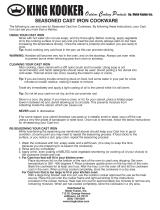
5 6
Maintain a Cast Iron Skillet
What is the best oil to
season cast iron with?
Clean it right away
Cast iron is easiest to clean right after cooking before the food has
a chance to become one with the skillet. As soon as it is cool enough
to touch, wipe out the food remnants with a towel and rinse it with
hot water. For a gentle and very effective cleaning method, scrub
your skillet with salt and hot water. Scrubbing your skillet with salt
and hot water with a non-metal scouring pad or the tough side of a
sponge is the gentlest way to clean it. The salt works as an abrasive
to scrub off food without damaging the seasoning.
Caked-on food can also be burned off. Place your skillet in an oven
turned to very high heat. The food will turn to ash, which can be
brushed off once the skillet has cooled down. If you use this method
you'll have to re-season the skillet, since the seasoning will get
burned off, too.
Don't use soap or a wire scrub brush on seasoned cast iron. It will
scrape off the seasoning, removing the nonstick surface allowing
moisture to react with the metal and create rust.
Unsaturated oils are best for seasoning because their chemical
structure is more reactive than saturated oils. This makes it easier
for them to polymerize to the metal. Saturated oils, like bacon
grease and lard, were commonly used in the past because they
were cheap, readily available, and unsaturated enough to get the
job done, but from a molecularly perspective they’re less than ideal.
While any unsaturated oil will do, there is a growing consensus that
pure, organic flaxseed oil is the best – especially for a major
re-seasoning. Its most desirable quality is that it is technically a
drying oil. That means Flaxseed oil starts to harden when exposed
to air, which can help create a rock hard polymerized layer on your
cast iron. Make sure the oil you purchase is organic, and that the
only ingredient listed is “organic flaxseed oil”.
If flaxseed oil seems a little too expensive or hard to track down,
nearly any unsaturated cooking oil will be fine. Some of the more
common ones we use are grapeseed, canola, or vegetable oil.
Completely dry the skillet on the stovetop or
in a hot oven
After you scrub it with the salt and water, rinse off and towel dry.
Again, fully dry the pan in a hot oven or by heating it on the
stovetop to evaporate any excess moisture and prevent rusting.
Add a protective layer of oil
Once the skillet is completely dry and still warm, carefully spread
a very thin protective layer of oil along the inside of the pan. Heat
the pan in a hot oven or on the stovetop until the oil begins
smoking. You want to bring the oil to its smoking point so that
it doesn't turn rancid.











